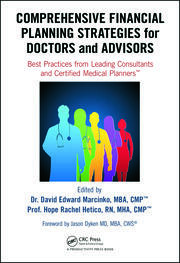The Capital Asset Pricing Model
By Jeffrey S. Coons; PhD, CFA
By Christopher J. Cummings; CFA, CFP™
While Dr. Harry Markowitz is credited with developing the framework for constructing investment portfolios based on the risk-return tradeoff, William Sharpe, John Lintner, and Jan Mossin are credited with developing the Capital Asset Pricing Model (CAPM).
Introduction
CAPM is an economic model based upon the idea that there is a single portfolio representing all investments (i.e., the market portfolio) at the point of the optimal portfolio on the CML and a single source of systematic risk, beta, to that market portfolio. The resulting conclusion is that there should be a “fair” return physician investors should expect to receive given the level of risk (beta) they are willing to assume.
Thus, the excess return, or return above the risk-free rate, that may be expected from an asset is equal to the risk-free return plus the excess return of the market portfolio times the sensitivity of the asset’s excess return to the market portfolio excess return.
Beta then, is a measure of the sensitivity of an asset’s returns to the market as a whole. A particular security’s beta depends on the volatility of the individual security’s returns relative to the volatility of the market’s returns, as well as the correlation between the security’s returns and the markets returns.
Thus, while a stock may have significantly greater volatility than the market, if that stock’s returns are not highly correlated with the returns of the overall market (i.e., the stock’s returns are independent of the overall market’s returns) then the stock’s beta would be relatively low.
A beta in excess of 1.0 implies that the security is more exposed to systematic risk than the overall market portfolio, and likewise, a beta of less 1.0 means that the security has less exposure to systematic risk than the overall market.
The CAPM uses beta to determine the Security Market Line or SML. The SML determines the required or expected rate of return given the security’s exposure to systematic risk, the risk-free rate, and the expected return for the market as a whole. The SML is similar in concept to the Capital Market Line, although there is a key difference.
Both concepts capture the relationship between risk and expected returns.
However, the measure of risk used in determining the CML is standard deviation, whereas the measure of risk used in determining the SML is beta.
Conclusion
The CML estimates the potential return for a diversified portfolio relative to an aggregate measure of risk (i.e., standard deviation), while the SML estimates the return of a single security relative to its exposure to systematic risk.
Now, if this is the essence of the Capital Asset Pricing Model, what are the arguments against CAPM?
***
Filed under: Portfolio Management | Tagged: Investing Basics | 2 Comments »


















